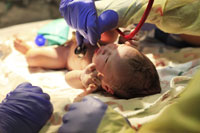

Mrs G, 34, presented to the delivery suite at 12pm, 38 weeks into her first pregnancy. Her antenatal care had been uneventful apart from measuring slightly “large for dates”. She was found to have a longitudinal lie with a cephalic presentation, and was experiencing three contractions every ten minutes. The midwife examined her and found her to be 2cm dilated with a fully effaced cervix and “intact membranes”.
At 3.30pm she was re-examined and found to be 3cm dilated and was given 100mg pethidine IM. At 8.30pm she was examined by the midwife again and still found to be 3cm dilated. The cardiotocograph (CTG), which had been started one hour before, was normal, with a baseline of 140b/min and good variability and good reactivity. Mrs G was now experiencing more painful contractions and an epidural was sited.
At 10pm, she was found to be 3cm dilated and the “membranes were still intact”, despite still having regular contractions of three every ten minutes. No artificial membrane rupture was carried out; however, Mrs G was started on a syntocinon regime by the midwife. There was no documentation as to whether this was carried out after verbal advice from the doctor or not, but no written prescription could be found on the drug chart, when the notes were reviewed retrospectively.
At 12.30am the CTG had become “suspicious”, with the baseline 150b/min and typical variable decelerations and the contractions were coming five every ten minutes. Dr A, the staff grade obstetrician on-call, was notified and he advised “verbally” to stop the syntocinon infusion, change the position of Mrs G and give her oxygen. The midwife felt the CTG improved after this.
M At 3am, Mrs G was re-examined and her cervix was found to be 6cm dilated with “bulging membranes”. These were artificially ruptured and she was found to have grade II meconium. The CTG baseline had risen to 180b/min and there were deep late decelerations and the contractions were still strong, coming four every ten minutes, despite having stopped the syntocinon. Dr A was informed, but he was “busy” and had still not arrived to review the CTG by 3.35am. He was re-contacted and came to assess Mrs G at 4am. He felt she was now “fully dilated” with the head at the level of the ischial spines. He decided to carry out a ventouse delivery, which was started at 4.15am. This was recorded as a “difficult delivery”, but no other documentation was made.
The 3.9kg baby girl was delivered at 4.35am with an Apgar score of 3 at one minute after birth, and 6 at five minutes. The cord gases showed severe metabolic acidosis with a pH 6.9 and BE-18 (arterial). The paediatricians were called subsequently and the baby was transferred to NICU. Although the baby survived, she had significant hypoxic ischaemic encephalopathy and severe cerebral palsy as a result.
Mrs G made a claim against Dr A and his team for their failure to adequately monitor her baby and recognise signs of fetal distress. This lack of communication between the teams and lack of recognition of the severity of the condition resulted in the infant having severe cerebral palsy, requiring lifelong care. The claim was settled for a substantial sum.
Learning points
- When things go wrong it is rarely because of a single isolated event. Errors and incidents occur within a system and
usually there is a sequence of events that occur before an accident happens.
- Although the mother and the baby were “adequately” monitored throughout the whole labour, the expert witnesses felt that there was significant substandard care in the interpretation of this CTG and the communication of the findings with the doctor involved.
- In this case the handover was poor throughout. A recognised handover model is a useful way of ensuring good communication and effective handover between health professionals and teams.
- All verbal advice about the proposed procedures should be carefully documented in the notes, eg, position of suction cup over the flexion point on the occiput, number of pulls (ideally less than three) and time for completion (less than 15 minutes). In this case there was a 20-minute time from application to delivery.
- The patient should be reviewed by the doctor before syntocinon is prescribed. The membranes should be ruptured before this is done because there is the risk of amniotic fluid embolism. The patient should be fully assessed on an individual basis, eg, signs of fetal distress on the CTG, frequency and strength of the contractions, previous obstetric history etc.
- If there is any delay in a patient being assessed by one member of a team, seek advice from a higher level to get this expedited (eg, supervisor of midwives, consultant).
- Whenever a suspected fetal compromised baby is to be delivered, the paediatric team need to be alerted, such that resuscitation can be instituted as soon as the baby is delivered. In this case the baby had to be transferred directly to NICU before appropriate resuscitation was started.